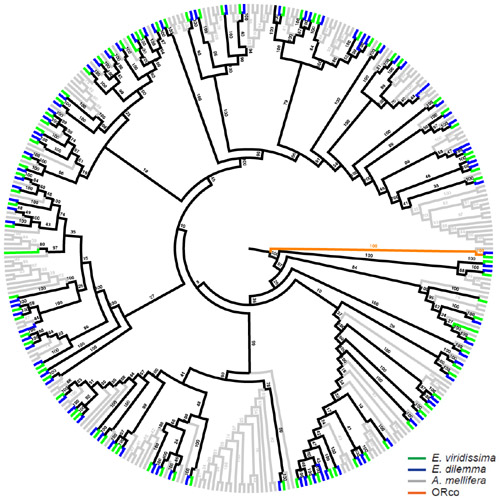Evolution of orchid bee odorant receptors |
|||
The detection of odors in insects is mainly mediated by the large and rapidly evolving gene family of odorant receptors (ORs) (Vosshall et al. 1999). Mutations leading to single amino acid changes in orthologous insect ORs can shift ligand-binding affinities of the respective receptor and lead to odor evoked behavioral differences (Richgels & Rollmann 2011; Leary et al. 2012). In perfume-making male orchid bees a shift in odor affinity might also change male sexual signals (the perfume) and thus alter both sender and receiver components of the mate recognition system (Eltz et al. 2008). In collaboration with Santiago Ramírez and Florian Leese we use high-throughput sequencing approaches to better understand the role of OR evolution in orchid bee perfume evolution and fragrance driven speciation. The construction of the antennal transcriptomes of the two orchid bee sibling species Euglossa dilemma and E. viridissima via RNA-Seq revealed that certain orthologous ORs of a set of reconstructed candidate genes are under strong diverging directional selection (Brand 2013; Brand et al. 2015). Amino acid changes in the odorant binding domains of these ORs suggest a role of OR differentiation in the observed differences of odor preferences and perfume composition. Recent functional characterizations of candidate ORs unraveled tuning congruent with behavioral odor preferences, in particular with regard to the major compound of Euglossa dilemma, HNDB (Brand et al 2020). References: Brand P., Hinojosa-Díaz I.A., Ayala R., Daigle M., Yurrita Obiols C.L., Eltz T., Ramírez S.R. (2020) The evolution of sexual signaling is linked to odorant receptor tuning in perfume-collecting orchid bees. Nature Communication 11:244. PDF Brand, P (2013) The evolution of odorant receptors in sibling species of orchid bees, as revealed by RNA-Sequencing. Master Thesis 131pp, University of Düsseldorf. Brand P., Ramirez S. R., Leese F., Quezada-Euan J. J. G., Tollrian R., Eltz T. (2015) Rapid evolution of chemosensory receptor genes in a pair of sibling species of orchid bees (Apidae: Euglossini). BMC Evolutionary Biology 15 PDF Eltz T, Zimmermann Y, Pfeiffe C., Ramírez Pech J, Twele R, Francke W, Quezada-Euan JJG, Lunau K (2008) An olfactory shift is associated with male perfume differentiation and species divergence in orchid bees. Current Biology 18, 1844-1848. Leary GP, Allen JE, Bunger PL et al. (2012) Single mutation to a sex pheromone receptor provides adaptive specificity between closely related moth species. Proceedings of the National Academy of Sciences, 109, 14081-14086. Richgels PK, Rollmann SM (2011) Genetic Variation in odorant receptors contributes to variation in olfactory behavior in a natural population of Drosophila melanogaster. Chemical Senses, 37, 229-240. Vosshall LB, Amrein H, Morozov PS, Rzhetsky A, Axel R (1999) A spatial map of olfactory receptor expression in the Drosophila antenna. Cell, 96, 725-736. |
|
RUB » Dekanat für Biologie und Biotechnologie » Evolutionsökologie und Biodiversität der Tiere - Mitarbeiterhomepage PD Dr. Th. Eltz


